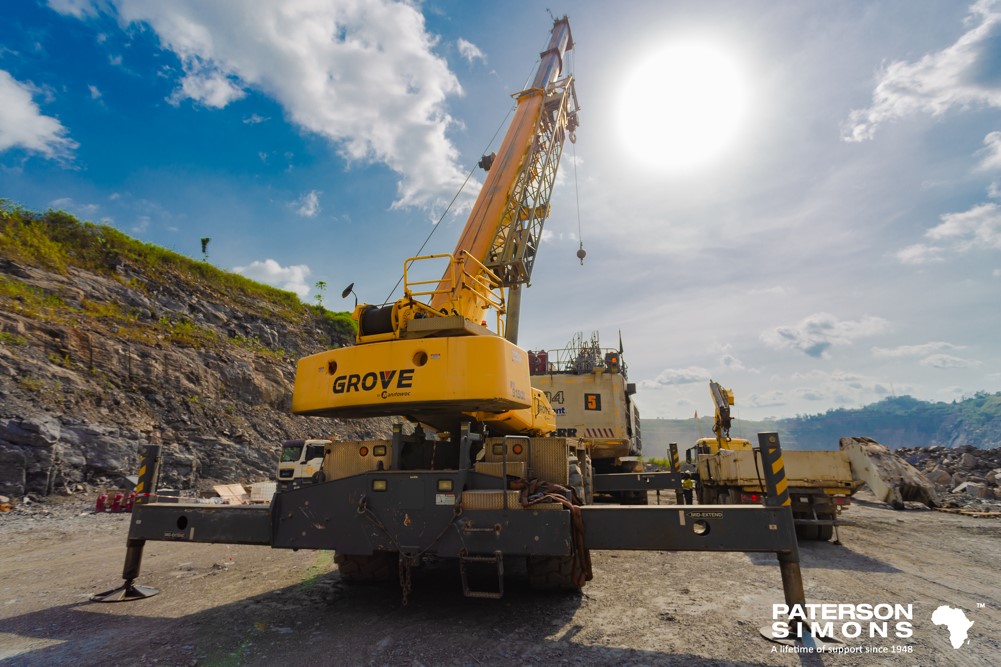THE NEW GUIDELINES FROM MANITOWOC FOR OWNERS AND OPERATORS OF GROVE ROUGH TERRAIN CRANES ON TRAVELING ON SLOPES
Crane operators need to exercise caution whenever operating Rough Terrain cranes on uneven surfaces. See below the new guidelines from Manitowoc for owners and operators of Grove Rough Terrain Cranes on traveling on slopes. Travel on slopes is permitted if the following conditions are met:
GENERAL CONDITIONS
1. Travel must be on an improved surface or on hard-packed dry earth. Operators are required to inspect the surface to ensure good tire adhesion.
2. All boom sections must be fully retracted.
3. The boom extension must be in the stowed position or removed.
4. The boom must be positioned over the front of the crane.
The boom angle limit is as follows:
- For fore/aft travel on grades not exceeding 15%, the maximum allowable boom angle is 20 deg. (Exception: For the RT9130E equipped with a 40,000 lb. Counterweight, the boom must be positioned at 0 deg.)
- For fore/aft travel on grades exceeding 15% the boom angle must be limited to horizontal (0 deg.)
- For side slope travel on grades not exceeding 10%, the maximum allowable boom angle is 20 deg. (Exception: For the RT9130E equipped with a 40,000 lb. Counterweight, the boom must be positioned at 0 deg.)
- For side slope travel on grades exceeding 10%, the boom angle must be limited to horizontal (0 deg.)
5. The swing brake and turntable lock pin must be engaged.
6. The hook block may be reeved over the boom nose and the overhaul ball may be reeved over the boom nose or auxiliary boom nose. Each must be secured to the tie down on the carrier to prevent swinging.
7. Tires must be inflated to the recommended pressure for pick and carry.
8. The hydraulic tank must be filled to the specified level and the fuel tank must be over half full.
9. No loads may be supported by the boom (i.e. no pick and carry loads) while traversing a slope.
10. All cribbing must be removed when traveling on slopes. If the customer has a specific non-factory addition that is to be considered, contact Manitowoc Product Support for further evaluation.
11. Avoid holes, rocks, extremely soft surfaces, and any other obstacles that might subject the crane to undue stresses and possible overturn.
12. The operator is to check for changing road conditions and engage the use of a ground person if deemed necessary.
Slope Limitations – Fore/Aft travel:
1. There are no restrictions for fore and aft slopes less than 15% (8.5 deg.), but travel speed must be appropriate for the terrain.
2. For slopes exceeding 15% but not 25% – transmission must be in 4WD. Do not park on these slopes unless the transmission is in 4WD and wheel chocks are used.
3. If you intend to leave the crane cab on any slope greater than 15% apply the park brake (rated for holding at 15%) and wheel chocks are required.
4. For slopes greater than 25% use of an assist vehicle is required and the transmission must be in 4WD. Do not park on slopes greater than 25%. The assist vehicle should be capable of traversing and holding on the given slope while attached to the crane.
5. Travel on slopes greater than 30% is permitted for short distances at low speed such as ramps. Consideration should be given to the terrain at the end of the slope (i.e. does it level out so that the crane can stop?) The crane should not be parked on slopes greater than 25% grade.
6. For mining applications and similar applications where the slopes and the travel distance can be significant, brake fade should also be taken into consideration. As is stated in the operator’s manuals: “For extended travel, check cold tire pressure before start (refer to tire inflation chart in the load chart book.) After every one hour of travel time, regardless of ambient temperature, stop and allow the tires to cool for at least 30 minutes. At your destination the tires must be allowed to cool to ambient temperature before lifting on rubber.”
7. The operator should carefully consider the conditions and travel at the appropriate speed given the condition. Do not exceed the maximum speeds in the tables below: Fore and Aft Slope Travel (table 1) and Side Slope Travel (table 2).
FORE AND AFT TRAVEL, NO LOAD – TABLE 1
The operator should carefully consider the conditions and travel at the appropriate speed given the conditions and should not exceed the maximum speeds in the table below.

Slope Limitations – Side slope travel:
1. Side slope shall not exceed 15% (8.5 deg.).
2. The operator should carefully consider the conditions and travel at the appropriate speed given the conditions. Do not exceed the maximum speeds in the table below.
SIDE SLOPE TRAVEL, NO LOAD – TABLE 2

The owner/lessee must take appropriate measures to ensure that all persons operating or working with the affected models are following Manitowoc’s recommendations. The operator of the crane assumes responsibility for determining the suitability of traveling on a slope. Traveling on a slope should be attempted under the controlled conditions specified in this publication and must be conducted with the utmost diligence and care to ensure the safety of all personnel performing the operation and/or working around the crane.
Should the operator of an affected model need to traverse slopes outside the criteria set forth in this publication or traverse slopes with other crane models not addressed herein, please contact the Manitowoc Product Support for further guidance.


